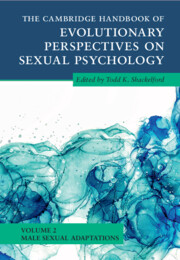Book contents
- The Cambridge Handbook of Evolutionary Perspectives on Sexual Psychology
- The Cambridge Handbook of Evolutionary Perspectives on Sexual Psychology
- Copyright page
- Contents
- Contributors
- Preface
- Part I Precopulatory Adaptations
- 1 Men’s Sexual Preferences
- 2 Men’s Extra-Pair Sexual Interest
- 3 Male Sexual Attraction Tactics
- 4 Men’s Intrasexual Competition
- 5 Competitiveness and Fatherhood as Overarching Domains of Female Choice in Human Evolution
- 6 Sexual Coercion and Rape
- 7 Mate Poaching by Men
- Part II Copulatory Adaptations
- Part III Postcopulatory Adaptations
- Index
- References
2 - Men’s Extra-Pair Sexual Interest
from Part I - Precopulatory Adaptations
Published online by Cambridge University Press: 30 June 2022
- The Cambridge Handbook of Evolutionary Perspectives on Sexual Psychology
- The Cambridge Handbook of Evolutionary Perspectives on Sexual Psychology
- Copyright page
- Contents
- Contributors
- Preface
- Part I Precopulatory Adaptations
- 1 Men’s Sexual Preferences
- 2 Men’s Extra-Pair Sexual Interest
- 3 Male Sexual Attraction Tactics
- 4 Men’s Intrasexual Competition
- 5 Competitiveness and Fatherhood as Overarching Domains of Female Choice in Human Evolution
- 6 Sexual Coercion and Rape
- 7 Mate Poaching by Men
- Part II Copulatory Adaptations
- Part III Postcopulatory Adaptations
- Index
- References
Summary
Despite a tendency to form socially monogamous pair-bonds that carry expectations of sexual exclusivity, infidelity has been a recurrent feature of human mating across societies. The attitudes, social cognition, affect, and behavior associated with infidelity vary in patterned ways between women and men. In the current chapter, we use an evolutionary perspective to make sense of the historical and cross-cultural ubiquity of extradyadic behavior, as well the adaptative costs and benefits of men’s infidelity. Specifically, we review theory and research pertaining to men’s extra-pair mating and consider salient individual differences, romantic relationship dynamics, and social–ecological factors that influence mating strategies and extradyadic involvement. Following other scholars, we argue that men have evolved adaptations for short-term mating that facilitate opportunistic extra-pair behavior in a “quantity-over-quality” reproductive strategy. Consequently, on average, men are predicted to express a stronger desire to engage in sexual infidelity and to have more permissive attitudes toward extradyadic involvement than women. However, only particular men appear to execute a mixed mating strategy involving a long-term mate and an extra-pair partner, such as those with greater mate value. Satisfaction with and commitment to the relationship appear to be crucial in preventing men’s infidelity, and socio-ecological factors, including cultural dynamics (e.g., norms surrounding infidelity) and sex ratios that create conditions of mate scarcity, are inextricably tied to men’s extra-pair mating.
Keywords
- Type
- Chapter
- Information
- Publisher: Cambridge University PressPrint publication year: 2022



